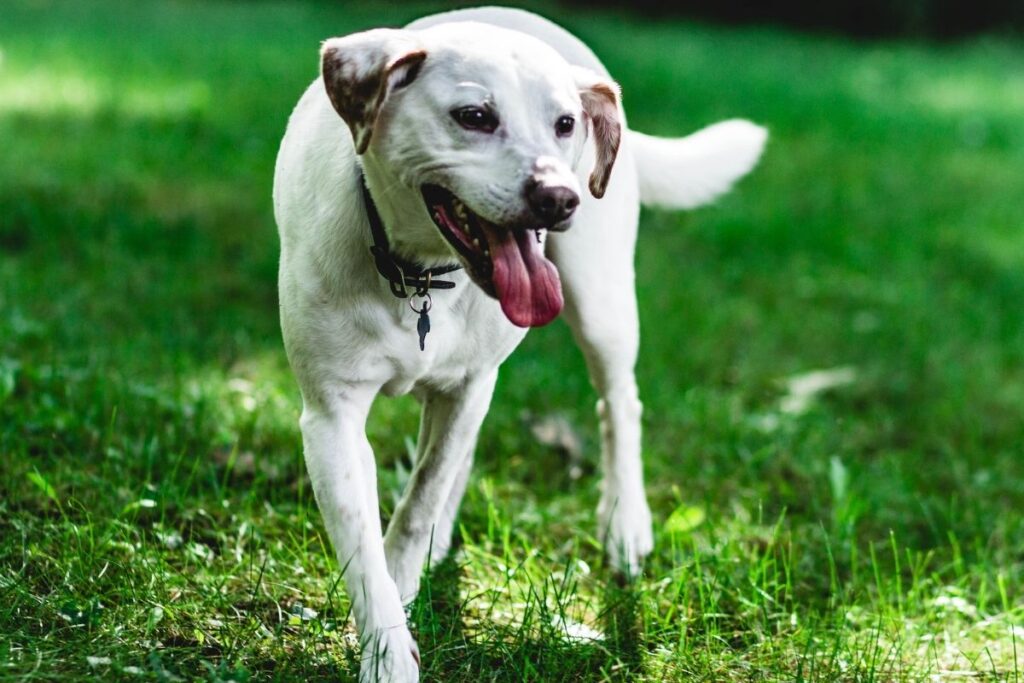Why Is My Dog Panting?
Have you ever looked at your dog and wondered, “Why is my dog panting?”. The answer to that lies behind a bigger question, “why do dogs pant?”. Well, let us guide you through the topic hoping that you get your answer and other relevant information that may be useful for you.

The Reasons Behind Dogs Panting
The reasons for panting can be:
- Homeostatic (Temperature regulation)
- Behavioral
- Chemical
- Medical
1. Homeostatic
Panting is a part of the body’s cooling mechanism in dogs. Dogs have two types of sweat glands called merocrine sweat glands and apocrine sweat glands. Merocrine sweat glands are located in the paw pads, and apocrine sweat glands are located in the skin throughout the body.
Merocrine sweat glands are activated in response to heat and release water (sweat) to evaporate, which is similar to the sweat glands in humans. Apocrine sweat glands, however, are more of a pheromone releaser. Therefore, their primary role is a pheromone secretion and does not involve evaporating sweat or acting as a cooling mechanism.
Since Merocrine sweat glands are located only in paw pads, the sweat glands of dogs are not efficient enough to remove the excess heat from the body on their own, unlike humans.
Panting increases moisture evaporation in the mucous membranes of the nasal passages, mouth, and lungs by rapidly moving the air in and out.
2. Behavioural
Stress, pain, and excitement are the psychological factors that trigger physiological changes in the body, mainly stimulating the adrenal glands to release cortisol and adrenaline. This results in increasing respiratory behavior, among other things.
Medical conditions that affect the adrenal glands and the regulation of stress hormones such as Cushing’s disease (Hyperadrenocorticism) and Addison’s disease (Hypoadrenocorticism) therefore impact the dog’s respiration.
3. Chemical
Some veterinary medications can trigger panting as a side-effect. For example, steroidal drugs such as Prednisolone are commonly known to affect respiration, and the dogs on those medications may be seen panting out of the blue.
Allergic reactions to certain stimuli may result in excessive breathing, dyspnoea, or panting. This is known as dog asthma, and it is due to an inflammation of the respiratory tract. This inflammatory response causes tightening and often spasming of the area and makes breathing more difficult.
There are different types of allergies that dogs can acquire. Food allergies are common, but there are environmental allergies and skin allergies also.
Exposure to certain toxic substances may lead to respiratory abnormalities such as panting. Routes of exposure can be ingestion, inhalation, dermal contact, and injection.
4. Medical
The respiratory tract is constantly under pressure in medical conditions such as respiratory diseases, laryngeal paralysis, collapsing trachea, cardiac diseases, anemia, and obesity. Therefore, panting is a more frequent occurrence for dogs with these conditions.
Unfortunately, some breeds are predisposed to get the aforementioned conditions more than other breeds.
- Cushing’s disease: Boston terriers. Dachshunds, Poodles, and Yorkshire Terriers.
- Addison’s disease: Bearded Collies, Great Danes, Labrador retrievers, Leonbergers, Nova Scotia Duck Tolling Retrievers, Portuguese Waterdogs, and Standard Poodles.
- Respiratory diseases: Brachycephalic breeds (short-nosed flat-faced breeds) such as Boxers, Bulldogs, Pekinese and Pugs.
- Laryngeal paralysis: Irish setters and Labrador Retrievers.
- Collapsing trachea: Chihuahuas, Lhasa Apsos, Pomeranians, Shih Tzu’s, Toy poodles, and Yorkshire terriers.
- Cardiac diseases: Cocker spaniels, English Springer Spaniels, Boxers, Doberman Pinschers, Great Danes, Irish Wolfhounds, Portuguese Waterdogs, and Saint Bernards.
- Anemia: Cocker Spaniels, Collies, Doberman Pinschers, English Springer Spaniels, Irish Setters, and Standard Poodles.
- Obesity: Beagles, Golden Retrievers, Labrador Retrievers, Pugs, and Staffordshire Bull Terriers.
What is Panting in Dogs?
Panting is a moderate to rapid open-mouth breathing action where the tongue is semi-protruding. It is characterized by a faster than normal respiratory rate, which should set about 20 to 30 breaths per minute. Shorter, more flat-faced breeds (i.e., Bulldogs, Pugs, Boxers) pant louder and more frequently than other breeds as they possess an elongated soft palate which can obstruct the upper respiratory tract.

The Differences Between Normal and Excessive Panting
Excessive panting is more frequent, constant (lasts longer than several minutes without a significant pause), and is categorized by heavy/labored breathing rather than normal breathing. It often occurs in conjunction with hypersalivation and discoloration (pale pink or blue) of the tongue and mucus membrane.
A dog with excessive panting may be depressed or restless and may show body tremors/shakes.
What Should I Do If My Dog Pants Too Much?
Excessive panting can lead to hypoventilation and insufficient oxygen intake/air exchange.
If possible, remove your dog from the situation that may have caused him/her to pant excessively as soon as possible. This could be a bright light, excessive heat, busy traffic, and any stimuli that can be stressful, painful, or overly exciting.
The important thing is to keep your dog calm, prevent the panting from getting worse, and place him/her in a quiet, cooler, darker room.
If your dog is suspected of having heat-induced panting/heatstroke, cool your dog by wetting the body thoroughly. You may offer water if they are capable of swallowing it.
What Does it Mean When my Dog is Panting at Night?
What about panting at night? Is it normal? Do we need to be concerned about it? Well, it all depends. It may be a side-effect of the medication if your dog is currently on any drugs that trigger excessive breathing (e.g., corticosteroids).
The room your dog sleeps at night may be too warm and causing a heat-induced panting behavior. In addition, your dog may be anxious to be separated from their favorite person/item, and therefore they are showing a sign of separation anxiety.
They may tend to consume food too quickly or overeat at dinner, causing discomfort and pain at night.
You may think of making some adjustments to improve the situation if the cause of panting is confirmed and it can be subdued at home without any veterinary intervention.
Here are some suggestions of adjustments that may improve the aforementioned situations.
Medication-induced Panting
- Discuss with a veterinarian about the possibility of using an alternative medication without respiratory side-effects that your dog can take instead.
- Discuss with a veterinarian about the medication schedule and the dosage.
Heat-induced Panting
- Set the room temperature (maintain the room temperature) at approximately 75.2 °F.
- Add some cooling aids such as a fan and a water bowl.
- Make sure your dog has access to a cooler area if they get too warm.
- Designate another cooler room as your dog’s bedroom (if plausible).
- Check the temperature of the room regularly.
Separation Anxiety
- Behavioral modification using desensitization and counterconditioning (This often requires the assistance of a professional veterinary behaviorist)
- Have your dog sleep in the same room with their favorite person/item (if plausible).
Gastric Upset
- Offer food in a slow-releasing bowl or in a food puzzle to avoid rapid consumption.
- Change the feeding schedule/frequency.
- Dietary modification (upon discussing with a veterinarian)
When Should You Call The Vet?
It is recommended that you contact a veterinary clinic and seek medical attention immediately when your dog is displaying the following signs:
- Panting excessively/abnormally for a period longer than several minutes without a significant pause and with no success in easing.
- Increased intensity of the panting.
- Also showing other abnormal signs.
- Suspected to be exposed to a toxin or an allergen.
The veterinary staff would want to know what prompted you to contact them, and it is essential for you to be able to describe the current situation that is concerning you in as much detail as possible.
In that way, they would be able to inform you if your dog requires urgent emergency medical attention or non-urgent medication attention. Either way, a veterinary check would likely be recommended.

The Bottom Line
The bottom line is dogs do pant for many different reasons in their everyday life. Therefore, it is crucial as a dog owner to understand the natural roles of panting in dogs and the differences between normal and abnormal panting so you can act promptly in case of an emergency.

